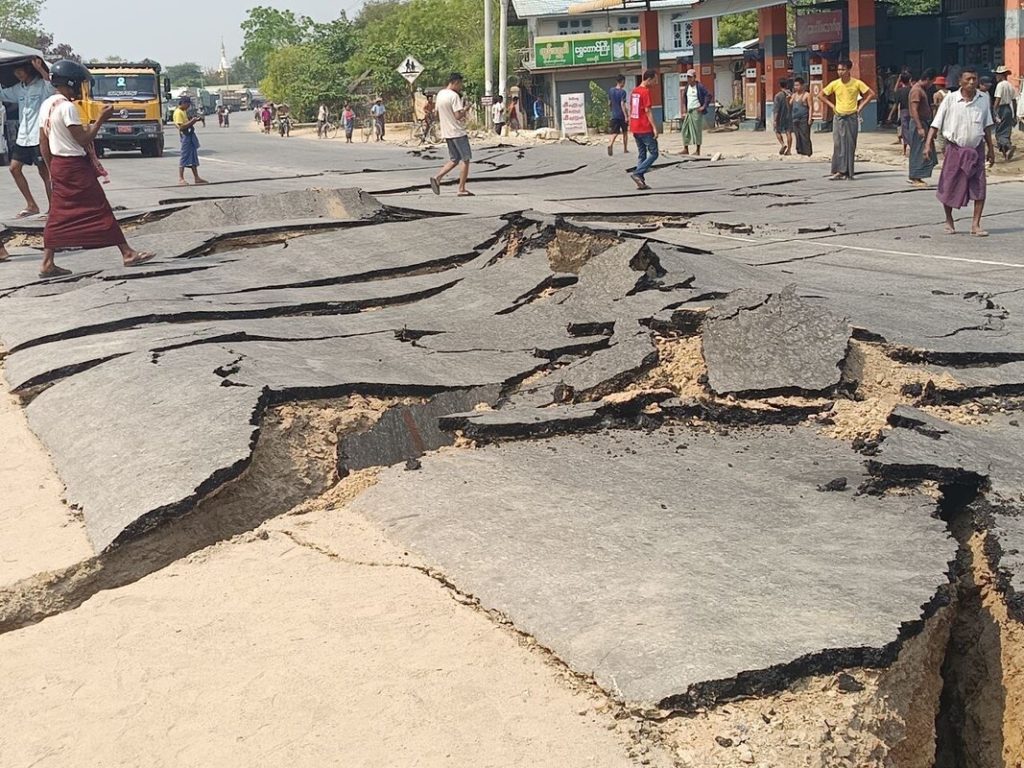In the wake of Friday’s devastating 7.7-magnitude earthquake, ActionAid is warning that Myanmar is now in the grips of an unprecedented humanitarian crisis. With at least 2,056 people confirmed dead and over 3,900 injured, the disaster has intensified an already critical situation where 20 million people were already in need of humanitarian assistance, and 3.5 million have been displaced by conflict and instability. Ongoing aftershocks and patchy internet access are slowing relief efforts as many communities have been without power for more than 72 hours.
Aung Min Naing, Programme Director of the Future Youth Development Organisation (FLYDO), based in the Sagaing region, was traveling through Mandalay to Yangon when the earthquake struck. He shared:
“On the day of the earthquake, I was on the way to Mandalay to take a bus to Yangon. I saw some red dust and collapsed buildings around me. But I did not know the whole city was collapsed behind me. Even though people heard some news of [the] collapse in Mandalay, they didn’t know so much damage was happening. They did not know that the whole city, Sagaing city, and a huge part of Mandalay was collapsing.”
The following day, Aung mobilised his team to begin response efforts. He told us:
“My team immediately went to Sagaing on the day after the earthquake. They arrived in the late afternoon and started meeting people to conduct the rapid needs assessment.”
What they found was a city in crisis.
“No restaurants are opening, and no food’s available — even dry food — nor any food shops are open. The primary needs at the moment are in Sagaing City, [where] about 80% of the buildings [had] collapsed. They are made of concrete in the urban areas. People just stayed in front of their damaged houses, without proper shelter, out in the open.”
Despite the devastation, FLYDO continues to work closely with affected communities, providing urgent support and identifying the most critical needs amid ongoing uncertainty.

Organizations in Myanmar have identified Mandalay and Sagaing as areas in urgent need of support, where communities have been hard-hit and immediate help is critical. In Mandalay, approximately half of the city’s buildings are reported to have been destroyed, and a key bridge has collapsed. In Sagaing, widespread fires and collapsed buildings are making it extremely difficult for emergency responders to reach those in need. Hospitals are overwhelmed, and extensive damage to health infrastructure has resulted in a severe lack of medical supplies, including trauma kits to treat the injured, blood bags for transfusions, anaesthetics, assistive devices such as crutches and wheelchairs, essential medicines, and even tents for health workers.
During Friday prayers, 60 mosques across Myanmar completely collapsed, killing 700 worshippers and leaving women and girls, who were not inside at the time, as some of the only survivors. Women, children, the elderly, and people with disabilities are among those most at risk in the aftermath of the earthquake. In the coming days, relief efforts must center on their needs, ensuring they have access to safe shelter, hygiene supplies for managing periods, and care for those who are pregnant, have just given birth, or are caring for newborns. Shelter is one of the most urgent needs, with many affected communities turning to traditional materials like palm leaves and bamboo, valued for their durability and familiarity, instead of tarpaulins.
As the humanitarian situation worsens, local organizations are coordinating a rapid emergency response, prioritizing shelter, food, water, and medical care for the hardest hit communities. Aid has begun to trickle in through the India–Myanmar border, with consignments ready to be collected and transported to Sagaing and other affected regions. However, with the delivery process expected to take around five days and roads either damaged or completely destroyed, the pace is far too slow to meet the urgent and immediate needs on the ground.
Jagat Patnaik, Head of Asia and Country Engagement at ActionAid International, said:
“Thousands of lives have been lost, homes destroyed, and many communities remain cut off. People fled with nothing, no shelter, no belongings, only the hope of reaching safety. Amidst the devastation, women and girls bear the heaviest burden. Forced into overcrowded shelters with little privacy or support, many are left caring for their families as well as themselves. Tragically, in some villages, they are the only ones left, after mosques collapsed during Friday prayers, claiming many lives. Local organizations are doing everything they can to reach those most in need, but access is still incredibly difficult. Time is critical as search and rescue teams continue efforts to locate survivors.”
ENDS
For media requests, please email christal.james@actionaid.org or call 7046659743.
About ActionAid
ActionAid is a global federation working with more than 41 million people living in more than 71 countries, including some of the world’s poorest countries. We want to see a just, fair, and sustainable world in which everybody enjoys the right to a life of dignity and freedom from poverty and oppression. We work to achieve social justice and gender equality and to eradicate poverty, including by shifting power to local organizations and movements.


